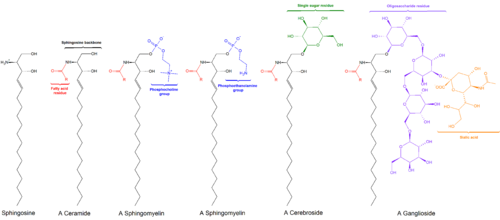This article needs additional citations for verification. (January 2023) |

Sphingolipids are a class of lipids containing a backbone of sphingoid bases, which are a set of aliphatic amino alcohols that includes sphingosine. They were discovered in brain extracts in the 1870s and were named after the mythological sphinx because of their enigmatic nature.[1][2] These compounds play important roles in signal transduction and cell recognition.[3] Sphingolipidoses, or disorders of sphingolipid metabolism, have particular impact on neural tissue. A sphingolipid with a terminal hydroxyl group is a ceramide. Other common groups bonded to the terminal oxygen atom include phosphocholine, yielding a sphingomyelin, and various sugar monomers or dimers, yielding cerebrosides and globosides, respectively. Cerebrosides and globosides are collectively known as glycosphingolipids.
- ^ Chun J, Hartung HP (2010). "Mechanism of action of oral fingolimod (FTY720) in multiple sclerosis". Clinical Neuropharmacology. 33 (2): 91–101. doi:10.1097/wnf.0b013e3181cbf825. PMC 2859693. PMID 20061941.
- ^ Schnaar, Ronald L.; Sandhoff, Roger; Tiemeyer, Michael; Kinoshita, Taroh (2022), Varki, Ajit; Cummings, Richard D.; Esko, Jeffrey D.; Stanley, Pamela (eds.), "Glycosphingolipids", Essentials of Glycobiology (4th ed.), Cold Spring Harbor (NY): Cold Spring Harbor Laboratory Press, ISBN 978-1-62182-421-3, PMID 35536927, retrieved 2024-09-10
- ^ Harayama, Takeshi; Riezman, Howard (May 2018). "Understanding the diversity of membrane lipid composition". Nature Reviews. Molecular Cell Biology. 19 (5): 281–296. doi:10.1038/nrm.2017.138. ISSN 1471-0080. PMID 29410529.